The directive n°2389/0133 of July 3, 1943, gave new instructions to paint the Soviet warplanes:
- the upper and side surfaces of all fighter aircraft were to have two colors: greyish blue and dark grey in the same scheme;
- upper and side surfaces of all types of aircraft but fighters had to be camouflaged in green, light brown and dark grey (black for Il-4 and Pe-8);
- the red stars remained in the same six positions of before, but were addictioned with a thick white outline and, more externally, with a further thin red outline.
- the directive applied to new planes and those in repair shops; it wasn't required that operative units repainted all their planes.
| Nitro lacquers for mixed construction planes | Oil enamels for all-metal planes | |
| light brown | AMT-1 | A-21m |
| dark green | AMT-4 | A-24m |
| black | not needed | A-28m (for Il-4 and Pe-8 only) |
| light blue | AMT-7 | A-28m |
| blue-grey | AMT-11 | not needed for non-fighter planes |
| dark grey | AMT-12 | A-32m |
The directive assumed that the non-fighter planes had to be delivered with the new camouflage starting from August 1, 1943; in the days before, black had to be replaced with dark grey.
In case of absence of dark grey, this would have been replaced by a mix of light blue and black.
The directive contained 15 camouflage schemes for many types, of which 14 were for non-fighter planes.
Two templates were dedicated to Il-2s; they were to be both to be implemented in the same factories and units to avoid an excessive repetitivity of the pattern.
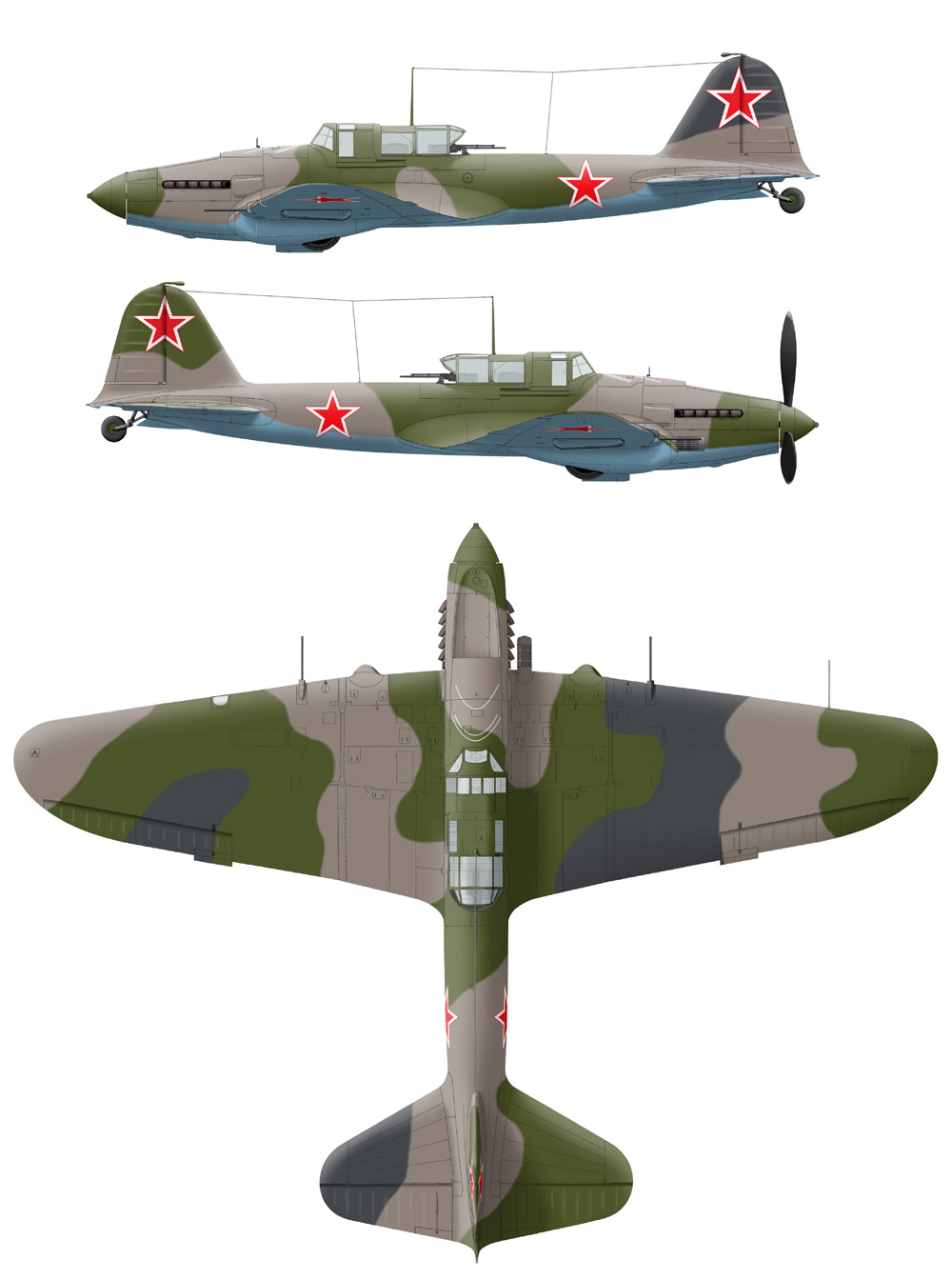
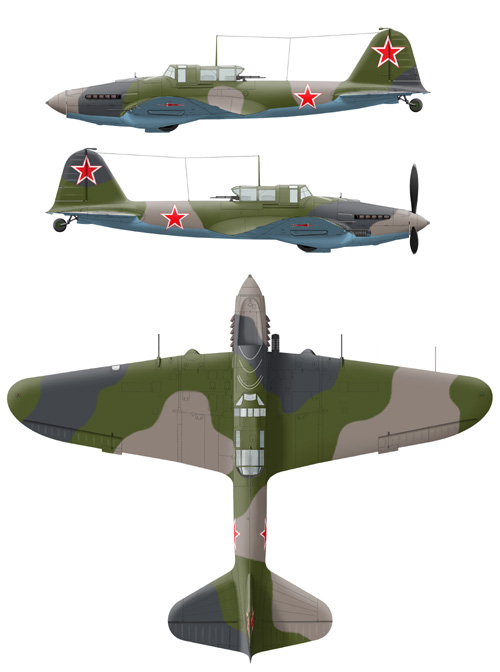
Zavod 1 in Kuybyshev
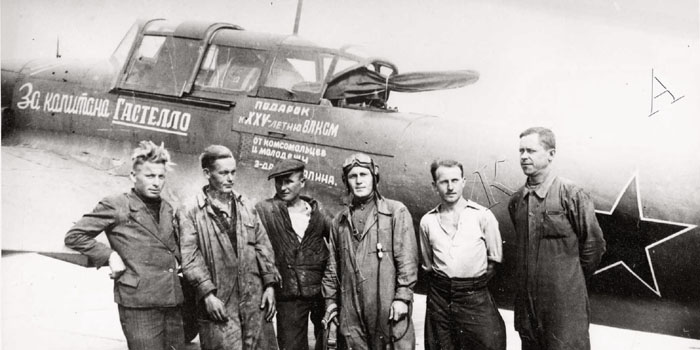
Some Il-2s entitled to heroes were built by Zavod 1 at the beginning of August 1943, just during the transition between the old style of camouflage and markings and the later one.
This plane, entitled Za kapitana Gastello, features the new green-grey-brown camouflage, while the red stars have only a tiny white outline (however, new for planes of Z.1).
(Image: Zaika)
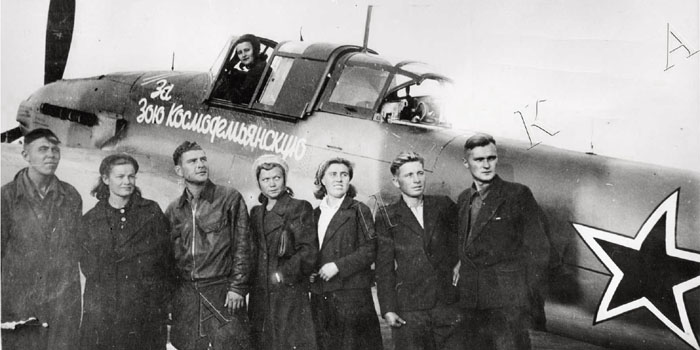
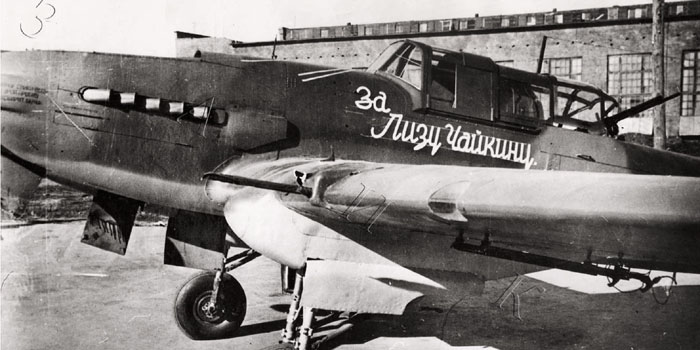
This plane was probably delivered by Z.1 few days after, and it has the definitive red star with thick white and thin red outline. The plane is entitled Za Zoyu Kosmodemyanskuyu.
This third image of the plane entitled Za Lizu Chajkinu, of the same batch of previous ones, allows to see the state of evolution of Il-2M at the beginning of August 1943:
- roof-type rear section of the canopy, fully hinged to starboard;
- short mast (350 mm, instead of the 800 mm mast introduced few months later)
- old type rocket rails;
- three white aiming lines on the nose
- new camouflage and markings.
Note also the rounded landing light typical of wooden wings of Il-2M.
On this photo the dark grey AMT-12 looks lighter than the green AMT-7; in other photos it's the opposite, while these colors are usually undistinguishable on bw photos.
(Image: Zaika)
Below: just for comparison, an image of the new flushed rocket rails for RS-82 and 132 rockets introduced few months later and likely contemporary to the longer radio mast (from a photo of Il-2M3).
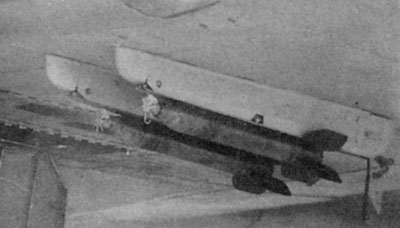
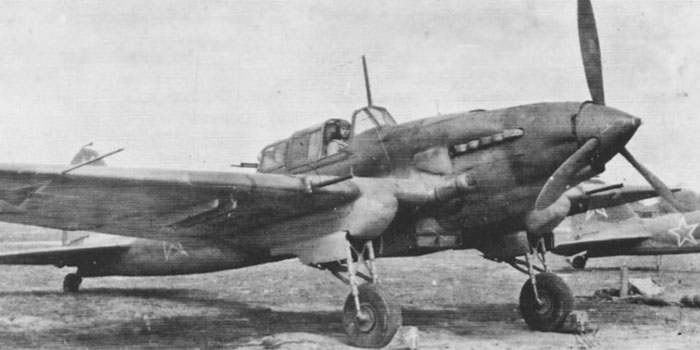
A good help to understand some distinguishing characteristics of planes built in Zavod 1 after August 1943 can be obtained by observing photos of Il-2KR, that were all built in that factory (apart for an early batch built in Z.30 before August 1943).
The characteristics seem:
- the long tail wheel fairing, whose rear cut was inclined towards the tail;
- medium to large stars, of variable size;
- sharp and rounded camouflage on the tail and wings, possibly made by mask (including a puzzle-like contour on the right wing of many planes), while the camo of the fuselage is blurred; it is unclear if this factory painted planes with the second template;
- wooden wings with rounded landing light windows.
The Il-2M3 preserved in Prague-Kbely, although being a later model and repainted, was built in Z.1 and shows some of these characteristics, as the long tail wheel fairing.

Plane n.14 has some variations introduced on the production lines probably in September or October 1943:
- long radio mast (800 mm instead of 350);
- flushed rocket rails (not visible in the photo);
- pitot probe closer to the wing tip.
So, late Il-2M becomes very difficult to be distinguished from the arrow-winged Il-2M of 1944, having identical fuselages and painting and differing only for the wing platform, scarcely visible in many images.
This photo allows a comparison between plane n.14, that has a straight wing, and n.50, that can be easily recognized as an arrow-winged Il-2M3 from this perspective.

Another screenshot from the same movie. The 'puzzle-like' camouflage of the right wing can be found of many photos of Il-2s, including some Il-2KR that were built in Zavod 1. So, this has to be the interpretation given by Zavod 1 to the template n.1 of August 1943. The camo of the wings and fuselage has sharp rounded lines, perhaps made by a mask. The fuselage painting looks much less accurate. The sharp descending forward dark grey band on the stabilizer looks characteristic of the camouflage n.1 made by Z.1.
Being built by Z.1, this plane of 1943 has to feature wooden wing consoles and rounded landing light window.
A nice characteristic of 14 and the other planes of this flight is the red (?) small cap on their tails.
A reconstruction of plane n.14.
Click on the profile to see a larger 3 views drawing.
An higher resolution version of the artwork will be published on the book on Il-2 of Jason Moore.
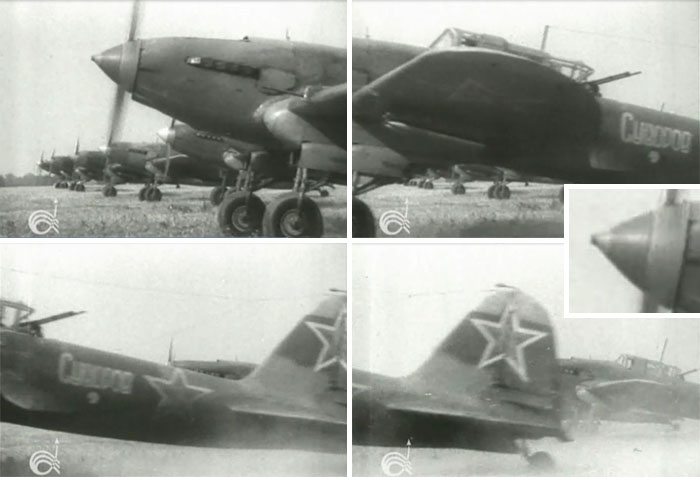
Four screenshots of the takeoff of an Il-2M flown by Vasilin Ivan, the regimental commander of 617th ShAP. The plane is entitled to Suvorov, the great Russian strategist of the 19th century. The plane is clearly a straight-winger with short radio mast and the post-August camouflage and markings. The images are probably of the late summer/fall of 1943.
On the background, we see a later model with the higher radio mast (800 mm instead of 350) introduced into production around September or October 1943.
The fingernail shape of the fairing of the tail wheel is noteworthy; after the summer 1943, it became characteristic of the planes built in Zavod 1. The most part of the planes visible in a video of this unit look of Z.1 also because of the very large stars.
The colors of the cap on the tail and of the spinner are reported by veterans:
- orange tail cap (and, probably, rear part of the spinner) as standard for 617th ShAP;
- 1st Squadron - red spinner tip
- 2nd squadron- white (?) spinner tip
- 3rd Squadron - yellow spinner tip.
Note the light brown repainting at the base of the stabilizer, common to many planes of the unit; they could be due to the deletion of a previous marking.
Lacking of bort numbers, it is likely that the inscription was painted on both sides to make the commander's plane more recognizable.
Thanks to Aleksandr Ruchkovsky and Vitaliy Timoshenko for the informations.
A reconstruction of plane 'Suvorov'.
Click on the profile to see a larger 3 views drawing.
An higher resolution version of the artwork will be published on the book on Il-2 of Jason Moore.
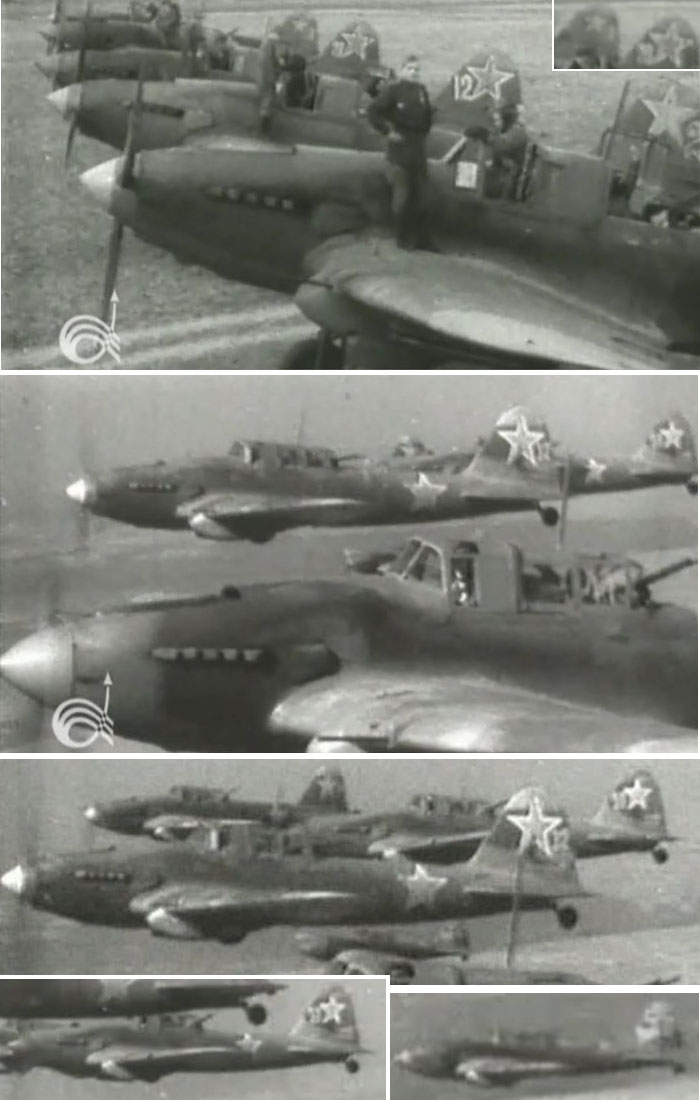
A collection of screenshots of other planes of 617 ShAP, probably the same visible on the background of 'Suvorov'.
The first plane seems to perform an orange and yellow spinner, separed by a thin white line; unfortunately the tail is not visible;
The second has the same style of spinner, but performs a wide 2 (possibly orange) and the star has a darker contour than other planes, possibly silver. Besides the nose has an unusual contour of the brown blotch that continues on the side, probably due to repainting on parts ruined by exhaust stains.
The third plane, white 12, seems to have orange and red spinner.
The fourth plane seems to have an orange and red spinner and bort number 23;
a fifth plane, scarcely visible. seems to have an orange-yellow spinner, a small red star on the tail perhaps without white outline and a bort number 1.
Thanks to Vitaliy Timoshenko for the informations.
Planes of the same unit in the same movie; many of them seem the same ones of the photo above, but it's not sure that they all are.
In this image inflight, plane 32 could be the same that was in first position on the image on the ground. The thumbnail shape of the tail wheel fairing and the large stars identify it as built in Zavod 1.
On the background, one of the planes shows a smaller red star and a tail wheel fairing Z.30 or perhaps Z.18. The number is unreadable, but it can't be the same '23' of the photo above because of the different size of the star.
Differently from the commander's plane, all other ones look to have the 'tall' radio mast; they hall have a light repainting on the fin's base, indicative of the deletion of a previous unit marking.
Details from other screenshots showing
- plane 32;
- the plane of Z.30 with unreadable number;
- the plane with 1 on the rudder and stars without white outline;
- another with a strange white blotch on the fin.
On the details we see:
left: plane supposed of Z.30
right: the plane with the blotch on the background. I wonder if it could be a '12' blended by the movie.
A reconstruction of plane supposed Orange 2.
Click on the profile to see a larger 3 views drawing.
An higher resolution version of the artwork will be published on the book on Il-2 of Jason Moore.
Il-2M of 617 ShAP white 15, characterized by a line drawing looking an eagle with a little lamb in its fangs.
The rear fuselage of the plane is well visible in a photo that I can't reproduce for copyright reasons.
The plane looks of Zavod 1 for its wide stars. The tail cap and spinner were drawn on the base of other planes of the same unit.
Thanks to Vitaliy Timoshenko for the informations.
Click on the profile to see a larger 3 views drawing.

Blue (?) 25 of 66 ShAP/140 Gv.ShAP is another straight-wing Il-2M with the new style markings and the short mast.
The tail stars are wide, so we can suppose it's built by Z.1; unfortunately other indicative details as the shape of the tail wheel fairing and the frame of the landing light window are not visible.
Thanks to A. Ruchkovsky and V. Timoshenko for their informations.

This photo, taken from the other side, shows that the pitot probe is in outer position and the wing is smooth, confirming its wooden construction. It shows also a very thin black (?) outline around the bort number.
The 25 on the tail can be supposed light blue (or, less likely, yellow) as the band across the fuselage; the tip of the spinner seems blue (or yellow) with a white trim. Note the Guards emblem on the nose.
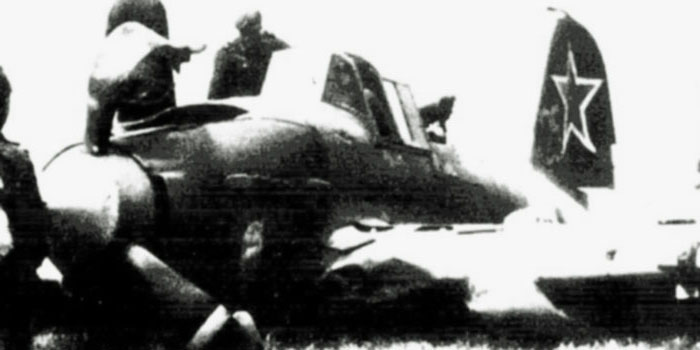
It's unclear if the white band across the prop blade is painted, or is due to its bending because of the belly landing.
From Profile Publication, Il-2 Shturmovik
A reconstruction of plane n.25.
The use of blue for the spinner and bort number is hypothetical.
Click on the profile to see a larger 3 views drawing.

The planes shown in this screenshot could be of 2nd Polish ShAD (the Polish personnel unit within Red Army).
The first plane, white 2, is a straight-winged one with short radio mast; the camouflage and markings are of the type introduced in August 1943; the plane could have been built in August or September 1943. The shape of the hood of the tail wheel suggests that this plane was built in Zavod n.1 and had wooden wings.
The second plane, white 7, seems to have a long radio mast, smaller stars and a different tail wheel fairing and camouflage not strictly following the standard templates; it seems to be built by Z. 18, so it probably has metal wings; this variant is a bit later of white 2.
A reconstruction of plane n.2.
The use of blue for the spinner is hypothetical, it looks too dark to be white as the outline of the star on the tail and the spinner of 7.
Click on the profile to see a larger 3 views drawing.
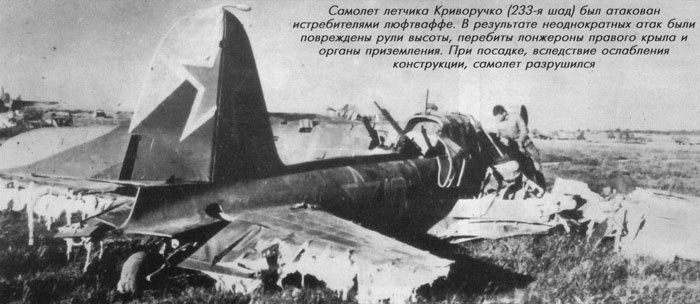
Red (?) 10 was flown by Ivan Davidovich Krivoruchko of 312 ShAP of 233th ShAD and shot down by German fighters. The oblique white cap is characteristic of the planes of this division. It could bear a blue tip of the spinner, because blue was the distinctive color of this unit, but this detail is not visible on the photo.
The plane has wooden wings, short antenna mast and the typical long tail wheel fairing introduced by this factory.
The wing shows very clearly the pattern 1 in the style of zavod 1 'puzzle', but it is brush repainted with colors more contrasting than on the tail and fuselage, perhaps after a repair.
Thanks to A. Ruchkovsky and V. Timoshenko for their informations.
A reconstruction of plane n.10.
Click on the profile to see a larger 3 views drawing.

Plane White 34 of 62th ShAP of the 233rd ShAD shows the typical oblique white cap of this division.
The front part of the spinner is glossy; probably it was red, the distinctive color of 62th ShAP.
The plane seems from Zavod 1 because of the large stars and the shape of the tail wheel cover; the tail wheel struts look covered by a flexible boot.
The camouflage looks to have received some repaintings; in particular, parts of the tail root seems repainted with a lighter shade of brown.

An Il-2 of 943 ShAP in Leningrad area in late 1943.
The plane seems to bear stars and camo in the style of Zavod 1.
Many details are unclear from the photo (the radio mast, the strange repainting near the number on the rudder...) but the image is interesting anyway for the double numeration and the unusual 3 digit number.
Image from http://www.photoarchive.spb.ru/showObject.do?object=2518155300
via A. Ruchkovsky.
A reconstruction of plane n.22-106.
Click on the profile to see a larger 3 views drawing.
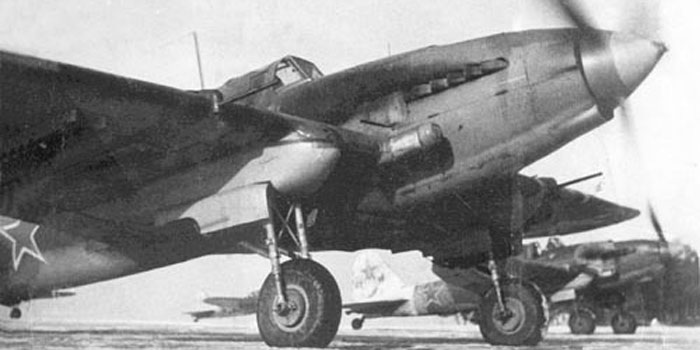
These planes with white tails probably were of the 233th ShAD. The planes could have a blue band in fuselage and a blue spinner's tip.
They seem late Il-2M of Z.1.
The closer plane seems to have a small red star painted on the tip of the spinner. The camo pattern is the second one of 1943.
The first plane on the background (red 24?) seems to show an unrecognizable individual painting on its white tail. It has the typical tail wheel fairing and camouflage of the first variant of August 1943 (the 'puzzle') .

A plane of 173 GvShAP (already 218 ShAP) of 11 Gv ShAD (already 299 ShAD) probably in Poland or Belarus in 1944. (Thanks to AR )
http://wio.ru/simbols/shad11g.htm
The tail wheel fairing of long type seems to identifies it as a plane built in Z.1 in late 1943, with wooden wings, tall mast, flushed rocket rails, pitot probe close to the tip. Note the removal of the rear section of the canopy. The straight shape of the wing can be confirmed by observing the alignment of the flap and aileron.
The camouflage of the nose seems the 2nd variant proposed by the NKAP instructions of August 1943, but the rear fuselage and tail don't seem to confirm this; perhaps the plane was subject to some repainting.
Noteworthy are the white rudder, red trim, the white band around the fuselage apparently contoured by thin red lines.
A reconstruction of plane 44.
Click on the profile to see a larger 3 views drawing.

Red 52 is of the same unit of red 44 and is extremely similar, apart for the camo pattern.
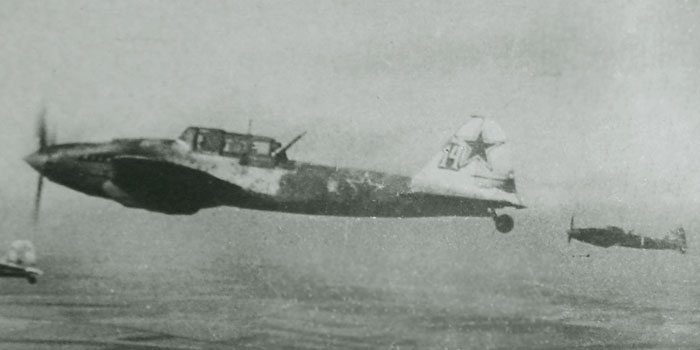
This late type Il-2M of 808 ShAP shows the typical tail wheel fairing of Zavod 1. The short radio mast identifies the plane as a straight-wing one built in late summer/fall 1943. The photo was probably taken in spring 1944.
The plane still bears white winter finish on the tail, central fuselage and possibly wings. A white 14 is visible on the tail stabilizer, in an unpainted rectangle. A very worn white band appears in mid fuselage, only a blotch is clearly visible. The band is clearly visible on the plane on the background
The base camo looks the first pattern, with a brown band amid the nose. The spinner looks of a medium shade, possibly blue.
Image via Vitaliy Timoshenko.
A reconstruction of plane n.14.
Click on the profile to see a larger 3 views drawing.
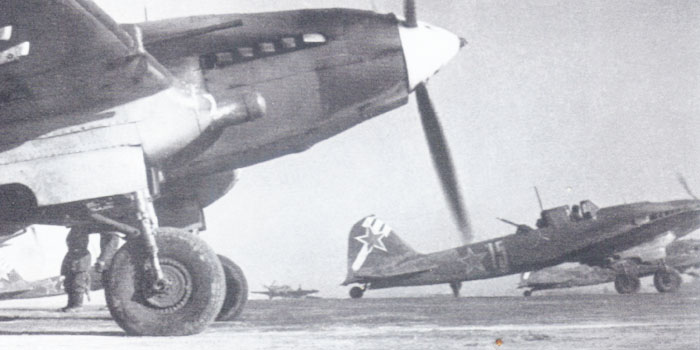
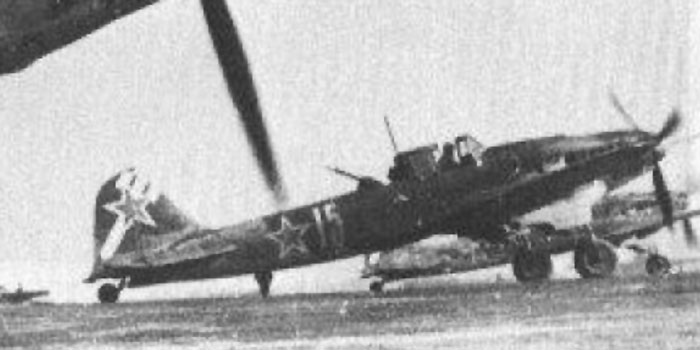
Those planes share a common unit mark well visible on the tail of n.15; according to the research of Gabor Horvath, it probably was the mark of 989 ShAP (136 ShAD, 17th Air Army, 3rd Ukrainian front), and the photos were probably taken in February 1945 on Kiskunlacháza (Budapest-S) airfield in Hungary.
http://ava.org.ru/shap/989.htm
Plane 15, as other ones visible on the photos, shows the typical tail wheel fairing of planes built in Zavod 1, whose planes were easily recognizable for the sharp and well contrasted camo on the rear fuselage, tail and wings.
The planes seem late Il-2M with straight wooden wing consoles.
The spinner of n.15, differently than the one of the closer plane, looks black and white.
The closer plane of the photo above had a small red star on the nacelle, while photos of other planes of the same unit don't show it; I have hypothetically drawn it on the views of n. 15.
A reconstruction of plane n.15.
Click on the profile to see a larger 3 views drawing.
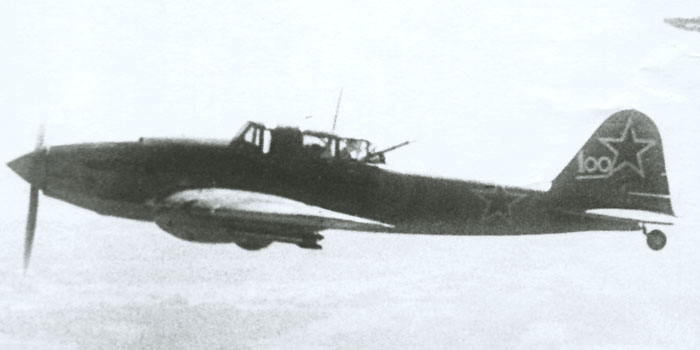
Il-2M of 228 ShAD division commander George Osipovich Komarov.
The size of the star and tail wheel fairing suggests that it was built in Z.1 in late 1943.
The most noticeable characteristic is the unusual style of the bort number 100.
Thanks to A. Ruchkovsky for his help.
A reconstruction of plane white 100.
Click on the profile to see a larger 3 views drawing.
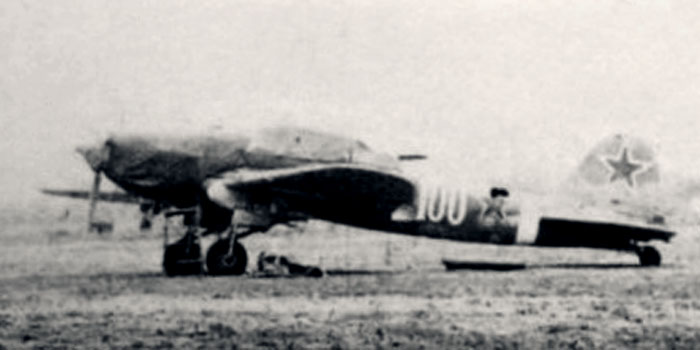
This plane 'White 100' was probably flown by Colonel Nikolai Pavlovich Terekhov, commander of 136 ShAD from July 1944 up to May 1945; Terekhov appears close to this plane on another photo.
From what we can see, the plane looks built by Zavod 1 because of the tail wheel fairing and the painting of the tail. The plane is a straight-wing one, probably with tall mast, and without the gunner's canopy.
Both the number 100 and the stars on the fuselage appear to have an intermediate angulation between the plane's axis and the ground. The spinner looks white, but there could be a cover on it. Seems that there was some repainting of the camouflage between the '100' and the red star on the fuselage.
Thanks to Vitaliy Timoshenko for the informations.

A reconstruction of plane n.100.
Click on the profile to see a larger 3 views drawing.
Another plane White 100 is this one of Ivan Panin of 210 ShAP in early 1944.
http://www.warheroes.ru/hero/hero.asp?Hero_id=15299
The profile is based on a photo that I can't publish for copyright reasons, from V. Timoshenko.
The plane, probably made in Zavod 1, shows a fantasious winter camouflage made with thin irregularly sprayed curved lines (often shaped as S, O, C, 3 etc) probably on a brown/green/grey base camouflage. The white 100 has a black outline and black 'moustaches' above and below the 'eyes'.
Other markings, if any, are unknown, because the photo shows only the part between the canopy and the star on the fuselage.
Click on the profile to see a larger 3 views drawing.

A line of Il-2M of 90th Gv.ShAP. We can recognize numbers 13 and 21. The planes look built in z.1 because of the shape of the tail wheel fairing.
A reconstruction of plane n.13.
Click on the profile to see a larger 3 views drawing.
The characteristics seem:
- the short tail wheel fairing, usually without any boot
- small to large stars, of variable size (but frequently small);
- blurred and very variable camouflage, where not always one can detect resemblance to the templates of 1943;
- always metal wings with squared landing light window.
Unfortunately the most visible characteristic if Il-2M3 of Z.18, the flushed fairing of the VYa-23, wasn't yet introduced in Il-2M, so the identification of planes built in this factory is somewhat difficult.
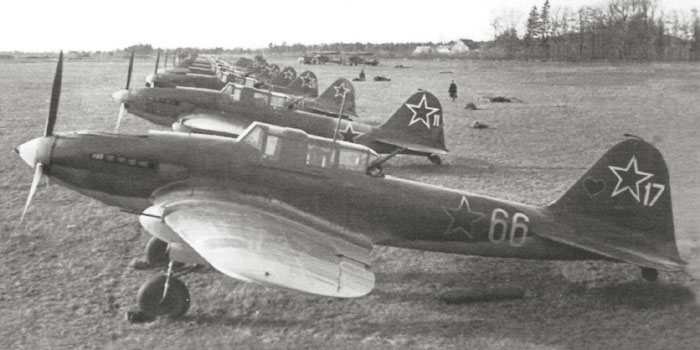
A line of Shturmoviks of 281 ShAD at Tartu, Estonia, in October 1944.
The plane n.66/17 was flown by the Hero of the Soviet Union V.V. Titovich.
The plane is interesting both for its double numeral and for the red heart painted on its tail.
Although this plane has often been described as an Il-2M3, the photo allows to identify accurately the perspective and to demonstrate that it's a straight-winged one. The panel lines visible on the wing reveal that the plane was built in Z.18.
The camouflage is scarcely contrasted and not recognizable, it could be a 3-shades camo with non-standard pattern. It's unclear why the contrast between colors is so low on the planes of this factory, perhaps grey and brown ave oversprayed in a thin layer over a green background.
The plane white 11, on the background, looks to have the long tail wheel fairing and the large stars of Z.1; it's difficult to say if it has straight or arrow wings, however its camouflage is much more contrasted than the one of 66/17.
(Image from 4+ Publications- Ilyushin Il-2M3 Shturmovik)
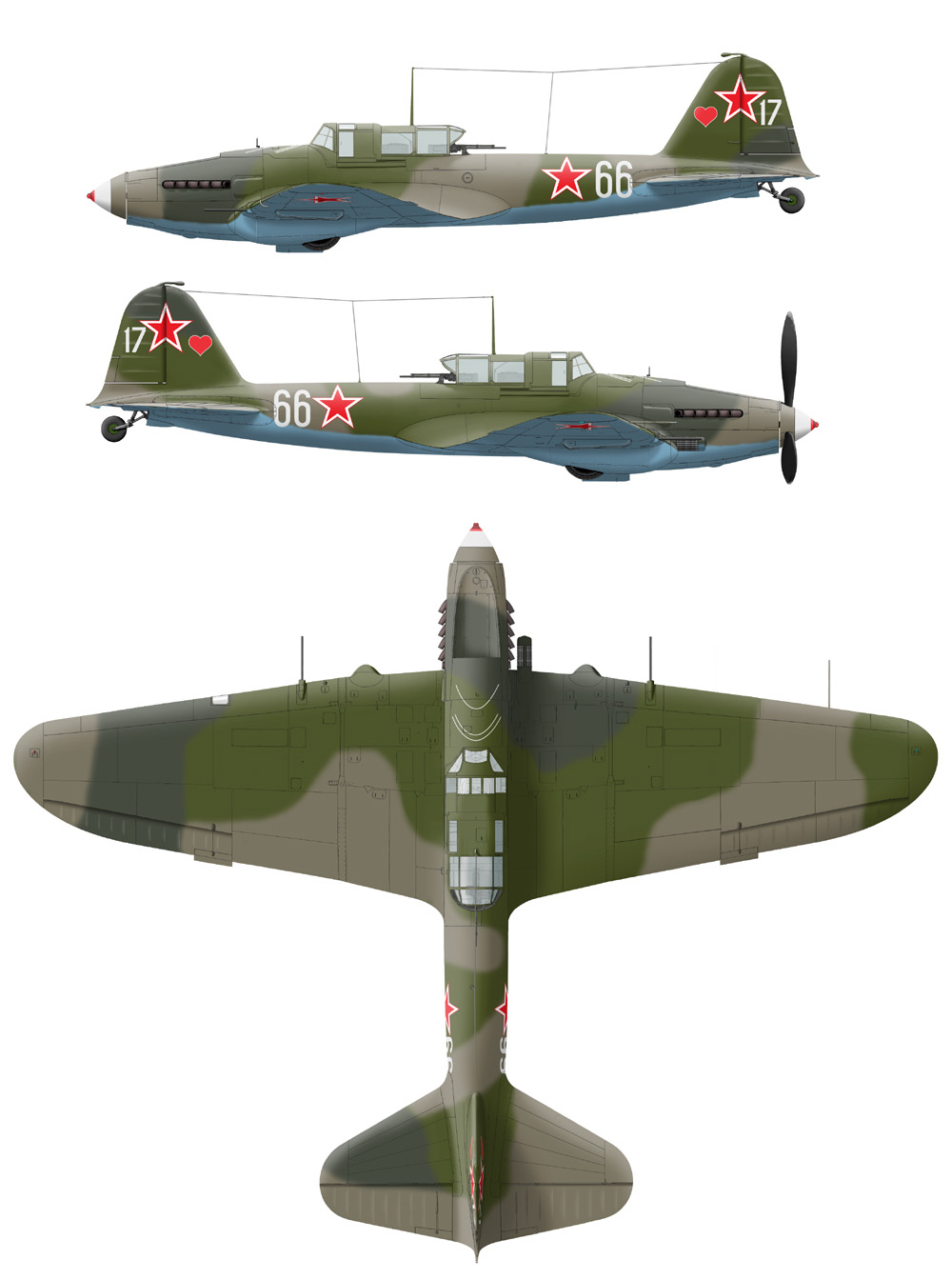

Plane white 27 of col. Nikolay Vasilyevich Chelnokov, commander of the 8th FGv.ShAP of the Black Sea Fleet.
The inscription says 'Za Zheniyu Lobanov', that means 'For Zheniya Lobanov'.
From other variants of the image, some panel lines can be seen on the wing edge, so it was metallic, typical of Zavod 18. The pitot probe is close to the wingtip, as typical of planes built after August/September 1943; the short mast identifies it as a straight-winged one.
This plane probably has the later type camouflage, perhaps the second variant that hasn't any light brown on the right side of the tail.
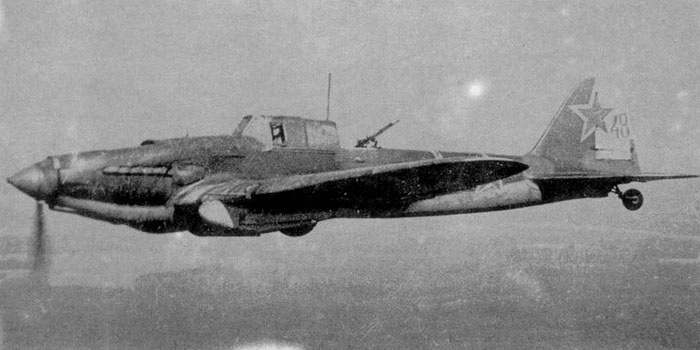
A plane of 431 ShAP (later 174 GvShAP) of 299 ShAD (later 11 Gv ShAD) probably in Poland or Belarus in 1944. This plane, very similar in painting to n.44, seems from Z.18, as one can deduct from the type of tail wheel fairing and the camouflage hardly fitting with standard templates.
The identification as straigh-winged is due to the fact that the Il-2M3 of Z.18 have a different type of fairing for the VYa-23 guns; besides the other similar known planes are straight-winged.
Note the white rudder with red 48 and tail trim. A white band, possibly with thin red outline (as that of n.44) looks to pass for the upper and side parts of the rear fuselage, but it doesn't extend on the undersurface.
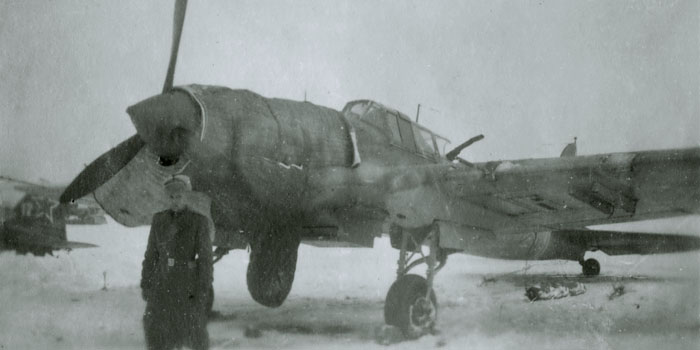
This plane seems built in Z.18 because of the angular shape of the landing light window. The camouflage is scarcely visible, but gives the idea to be of the newer type, and what can be seen of the star on the fuselage seems to confirm this. Two thin white stripes run around the fuselage just close to the tail.
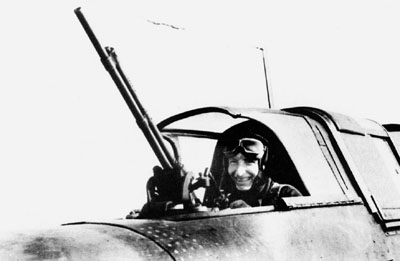 The
main reason of interest is the unusual type of rear canopy, with curved
cuts to increase the field of fire of the machine gun. This is a very
rarely seen variant (or, perhaps, field arrangement) probably built
in mid 1943 before the introduction of the roof-style hood. On the other
hand, the rocket pylons are of the flushed type introduced after August
1943.
The
main reason of interest is the unusual type of rear canopy, with curved
cuts to increase the field of fire of the machine gun. This is a very
rarely seen variant (or, perhaps, field arrangement) probably built
in mid 1943 before the introduction of the roof-style hood. On the other
hand, the rocket pylons are of the flushed type introduced after August
1943.
Right: photo of the same style of canopy on another plane.

An Il-2m white 6 probably photographed in winter 1943/44; the white winter camo with MK-7 washable paint was still utilized in that period.
The white dots made with temporary MK-7 finish put in evidence the contours of a wide and scarcely visible white-bordered star on the fuselage. The size of the stars and the style of the tail wheel fairing suggests a plane built in August-September 1943 with the new camouflage, but it could also be an older plane with black-green camouflage and updated red stars.
Note the removal of the back canopy section.
(From Squadron-Signal, Ilyushin Il-2 in action)
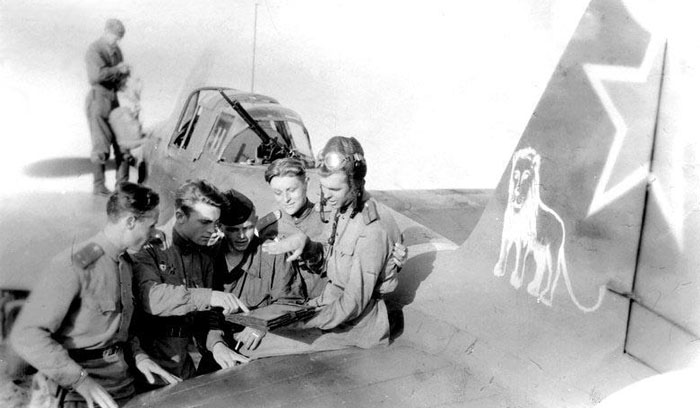
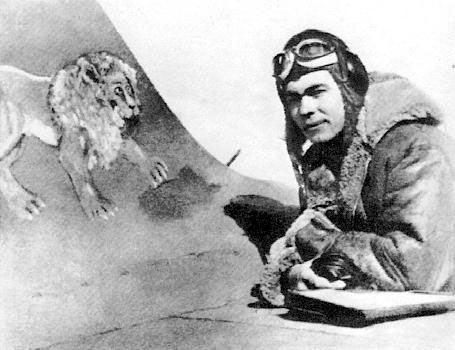
The plane of Vladimir Abramovich Aleksenko, squadron commander, and later regiment commander, of 15 Gv.ShAP, Leningrad/Baltic area. The photo is thought to be of fall 1943 or summer/spring 1944.
http://www.warheroes.ru/hero/hero.asp?Hero_id=252
The photo shows a lion painted in white on the left side of the fin, and a thin white band around the fuselage, probably with thin red outlines. Something white, possibly the bort numbers, is vaguely visible between the men.
According to a Russian reconstruction, the plane was numbered white 07 and had a silver painted spinner, according to what said by the pilot himself.
Unfortunately it's not known from which factory the plane came from. It could be Z.30, that utilized stars of that size.
Here is the pilot with the lion painted in colors on the right side of the fin. Seems that the lion is attacking a prey, that appears as an ill-defined blotch (or perhaps it's only a repair).
Thanks to Vitaliy Timoshenko for the informations.

Planes of 15 Gv.Shap, probably in fall 1943.
The plane 07 on the background could be the same one, perhaps before the application of the white band and of lions and of the reported silver paint on the spinner.
The plane looks built in Zavod 30, also because of the position of the star on the fuselage.

A reconstruction of plane 07, partly made on the base of the apparently similar plane 09 of Deryabin (photo below).
Click on the profile to see a larger 3 views drawing.
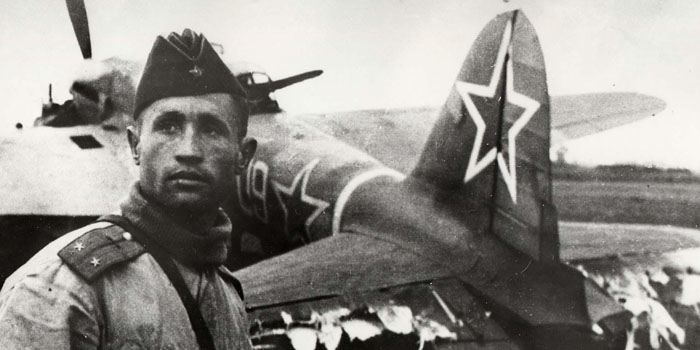
Plane 09 of pilot Deryabin of 15 Gv.ShAP. This is thought to be similar to the one of Aleksenko, apart for being produced in another factory, as suggested by the size and position of red stars.
No lions here, but both the white band and the number 09 on the fuselage look to have a thin red outline.
Note the impressive damage to the elevators.
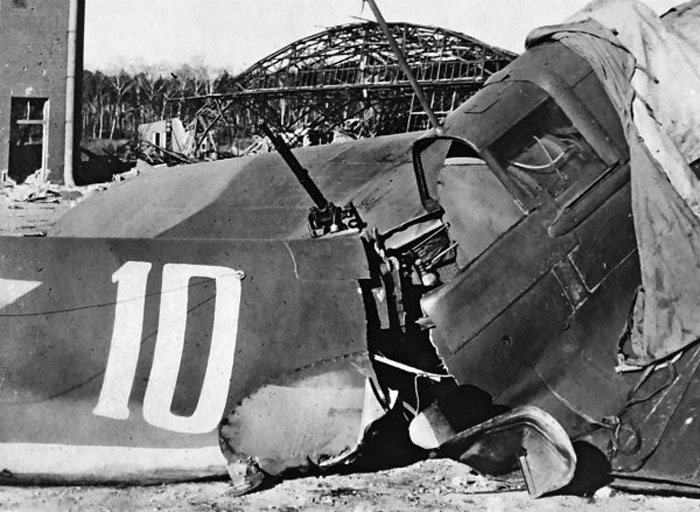
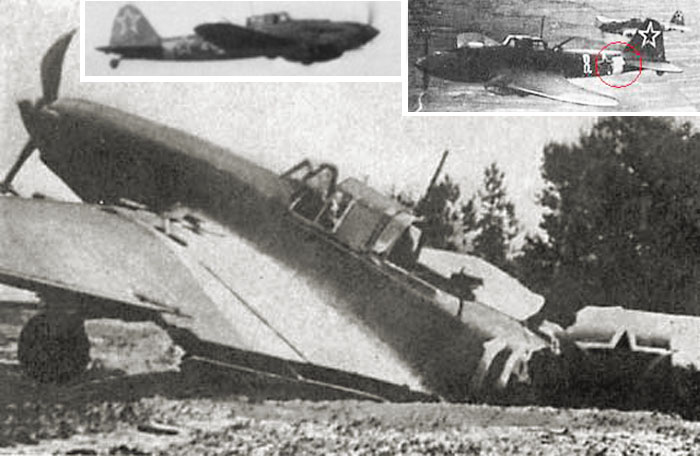
Plane White 10 was flown by A.I. Trukhov, commander of 103 ShAP.
On 22 March 1945, he guided a group of 6 planes into an attack in Danzig, but his plane was badly hit by an AA shell in the fuselage, wounding the crew. Trukhov managed to return to his airport and the wounded gunner left the plane with a parachute, then the fuselage broke completely during the landing.
The first photo shows a sharp white area under the fuselage; 1n 1945, all Il-2s of 103 ShAP received a layer of white painting under the fuselage as regimental recognition marking, supplementing the white band brought on the rear fuselage (sides and below only) by all planes of 103 ShAP, as shown in the small photos below. http://wio.ru/simbols/shad230.htm
It is unclear if the area above the white undersurface, visible in the photo, was repainted in light brown or preserved the original blue shade (in this case, the contour of the blue area was unusually high).
It's possible that the plane had the number 10 painted on the right wing uppersurface too, as seen on plane 8 of the same unit and on other planes (26, 27) of other regiments of the same 230 ShAD.
The photos allow to see that plane 10 was a straight-wing Il-2M with metal wing consoles, as typical of the production of Z.18 in late 1943.
The camouflage pattern was reconstructed on the base of these photos and of other Il-2s built by the same factory.
Images and informations via Vitaliy Timoshenko.
A reconstruction of plane White 10 of A.I. Trukhov.
Click on the profile to see a larger 3-views drawing.

The key to deduct the visual characteristics of the planes built by Zavod 30 is the observation of Il-2-37, all built in the second half of 1943 by the same factory. Here is an Il2-37 without the guns, but with the gun pods visible under the wings.
They feature:
- medium to small sized stars;
- blurred, simplified camouflage;
- wooden wings with rounded landing light window (as planes of Z.1);
- short and narrow tail wheel fairing, sometimes with a flexible boot.

Exceptional image of the underside of an Il-2M.
The rounded landing light window suggests that it has wooden wing consoles. Some stripes reinforce the fabric layer over the wood skinning.
From the shadows, it seem that the rocket rails are of the later 'flushed' type. Note the narrow tail wheel fairing, that is not the type of Z.1; so this plane has to be of Z.30.
Note the dark traces of the exhaust fumes on the tail surfaces; traces of smoke are behind the waste shells expulsion slots and the rocket rails. As we see, on late type Il-2s, the small windows of the hinges on the ailerons were covered by thin plates, instead of being uncovered as on early versions of Il-2.
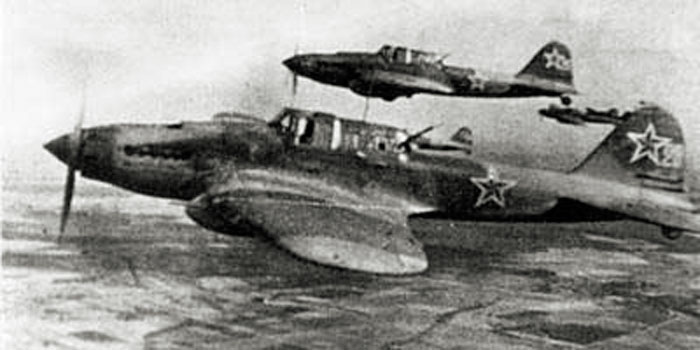
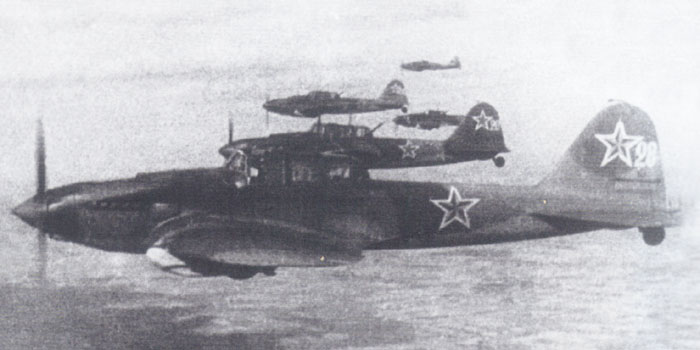
Il-2M of the 6 GvShAP in August 1944. Planes n.28, 20 and 15 are recognizable.
In the photo above, the plane 28 is identified as a straight-wing one instead of a swept-wing one by tracing a perspective line between the visible wingtips and comparing the rear edges of the visible wing.
The size of the stars is small, seems typical of Z.30; so these planes of 1943 have wooden wing consoles with rounded landing light window and thin tail wheel fairing, possibly with leather boot (at least, on plane n.20).
White 28 shows the same camouflage according to the first template of August 1943; the blurred and V-shaped contour allow to distinguish this interpretation of the template 1 of August 1943 by that of Zavod 1, that was sharp and descending forward.
Plane n.28 is characterized by the kremlin stars both on the fuselage and on the tail (probably the underwing stars were ordinary).
Plane n.20 looks painted according to the second template of August 1943.
As in many other photos, the light brown of bands on the aft fuselage looks darker than that on the rear fuselage; this could be due to the heat and smokes of engine and/or a somewhat different shade of the A-21 brown oil paint when compared with the light brown AMT-1 utilized on the wooden rear fuselage.
(Image below from 4+ Publications- Ilyushin Il-2M3 Shturmovik)
Below: a drawing of n.28 made for the book on Il-2 of Jason Moore.
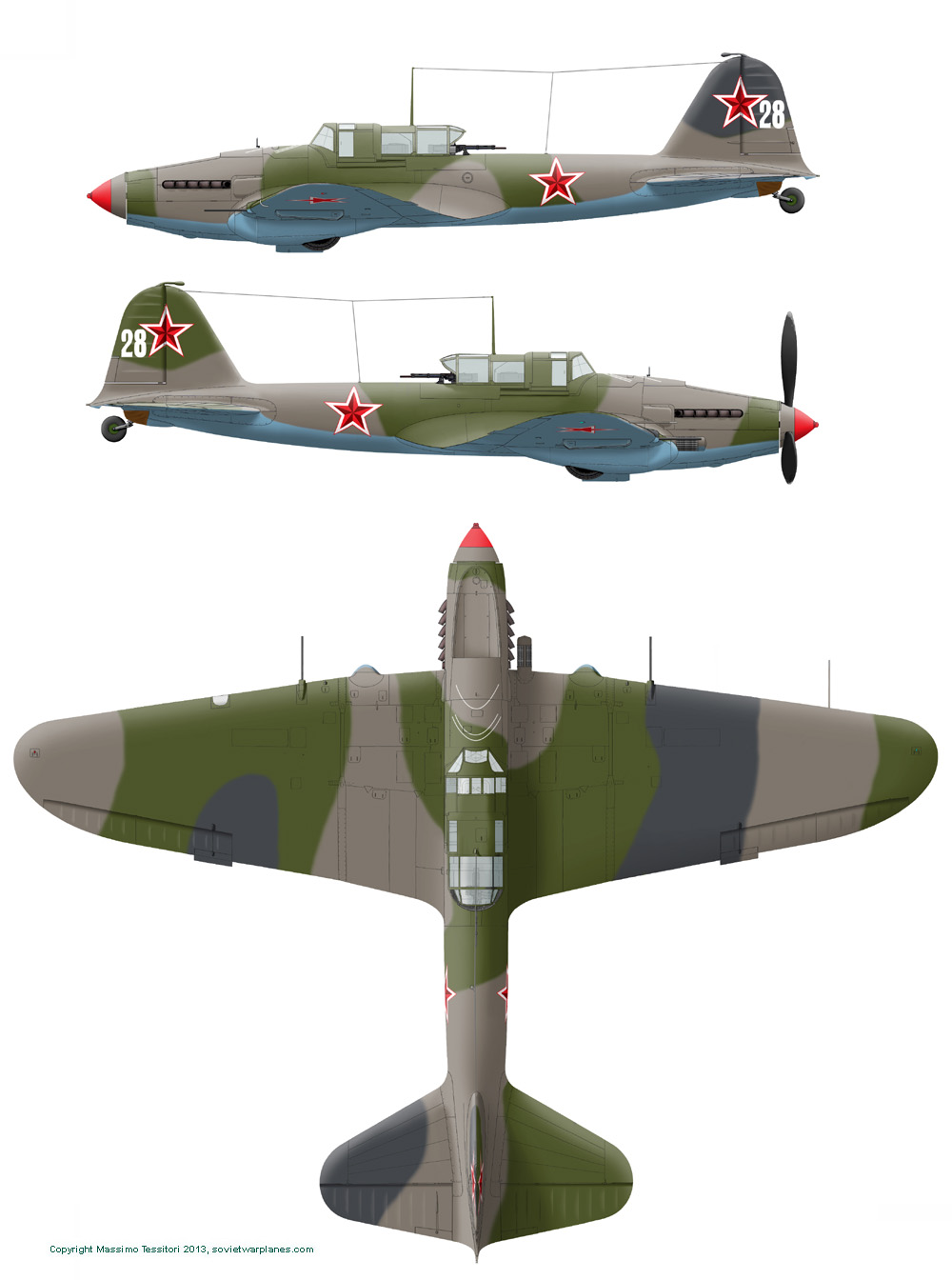
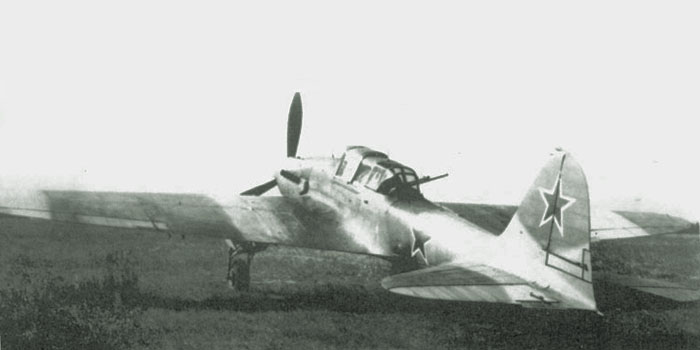
Even if it's an Il2M3 with arrow metal wing and B-20 gun, this photo allows to see well the style of camouflage of wings thought to be of Zavod 30. The bands have the same position of the official templates of NKAP, but their outlines are more straight and longitudinal; besides they're soft, differently than the sharp and curved lines of Zavod 1. In this photo, green seem to appear darker than the dark grey.

Another line of late type Il-2M with 'small' stars, presumably built by Z.30 with wooden wing consoles. The long radio mast suggests that the planes were built in fall 1943. The photo was taken on 14 August 1944.
Plane n. double 17 has a leather/tissue boot on its tail wheel, supporting the idea that it was built by Z.30.
The image shows that the first, third and fourth planes wear the 1st pattern of August 1943, while the second plane was the only one to wear the second variant of the camouflage.
Reconstructions of plane double 17.
Click on the profile to see larger 3 views drawing, showing the well known variant of the 1st template of Zavod 30 on double 17.
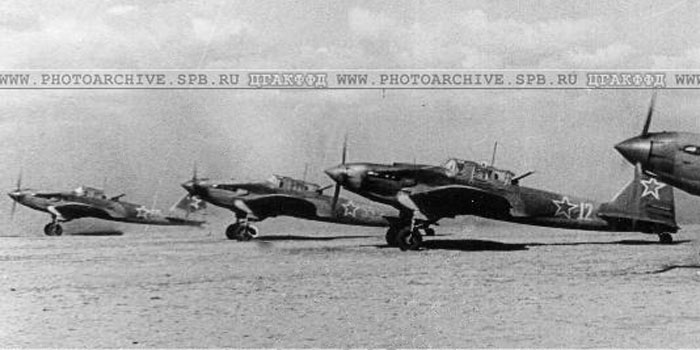
This image shows that plane n.12, 55 and the last one with unreadable number (35?) hadn't the same double numeration of white 17.
All the planes look built in Z.30 in the fall 1943.
N.12 was the only one to wear the second variant of the NKAP camouflage.
Reconstruction of plane white 12.
Click on the profile to see a larger 3 views drawing, showing a reconstruction of the scarcely known uppersurface of planes of Zavod 30 with the 2nd template, that was simpler and more 'longitudinal' than the sketch of NKAP.
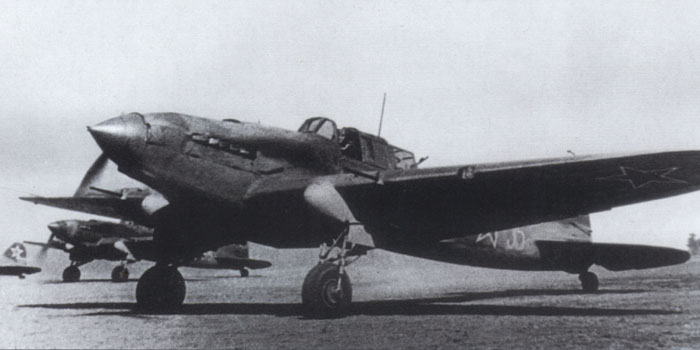

This plane n.35 seems the one appearing on the background of the photos above. The photo is of 21 March 1944.
The lack of the 'roof' to the canopy is probably due to a photo manipulation, because its frame is visible through the glazing.
Plane n° 55, on the background, looks painted in good accord to the second template of 1943.
(Image from 4+ Publications- Ilyushin Il-2M3 Shturmovik)
A reconstruction of plane white 35.
Click on the profile to see a larger 3 views drawing.
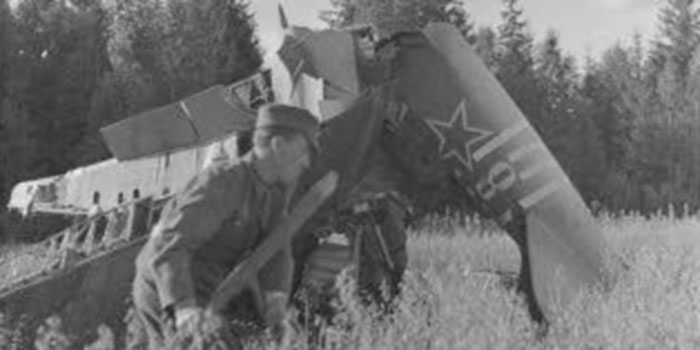
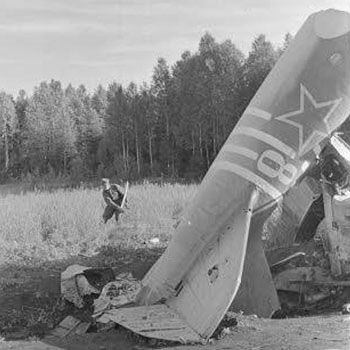 Two
interesting photos of a wreck of a plane, white 8 fallen in Finland.
Two
interesting photos of a wreck of a plane, white 8 fallen in Finland.
Four white stripes around the fuselage as an identificative mark suggests that it could belong to 999 ShAP at the time of Vyborg operation in 1944.
The alignment of the aileron hinge line (on the lower surface their chord is wider than on the upper one, the step is visible as a light line in the photo) to the flaps hinge line suggests a straight-winged plane. The way the wing is broken suggests it is wooden. The relatively small size of the red star suggests a plane built in Zavod 30.
A reconstruction of plane white 100. Click on the profile to see a larger 3 views drawing.

Interesting image of plane 21, probably of 593 ShAP. The size and style of the stars identify it as a plane built in Z.30 in late 1943. The wing can be recognized as a damaged and deformed straight wooden wing.
The divided ammo hatches have created the doubt that this could be an Il2-37, but it seems to see the rear of the rocket rails through the break in front of the aileron, and this characteristic was missing on Il2-37.
The bort number 21 was contoured in white or silver paint; the outline of the fuselage star seems too dark to be white, it could be silver or even yellow. According to a research based on the memoirs of veterans, planes numbered from 01 to 12 had red numbers and spinners, planes from 14 to 26 had blue ones, and planes from 27 to 38 had yellow ones.
According to the same source, the regimental mark was completed by a white undersurface of the left wing only, from the aileron start to the tip; a thin red longitudinal line divided the white part of the undersurface from the light blue one.
The regimental marking on the tail, an interrupted white line with a red (?) contour, is particularly interesting.
On the background, we see the apparently similar 'red 14'.
Image from http://forums-su.com/viewtopic.php?f=194&t=583322

A reconstruction of plane blue 21.
Click on the profile to see a larger 3 views drawing.
Thanks to Vitaliy Timoshenko and to Aleksandr Ruckovsky for their informations and suggestions.

















